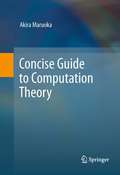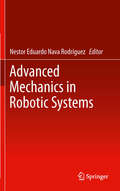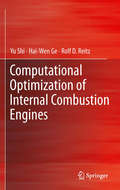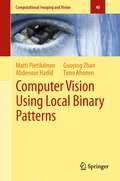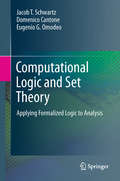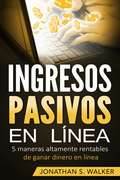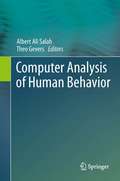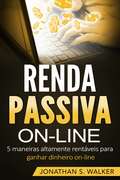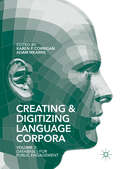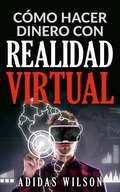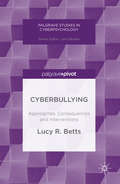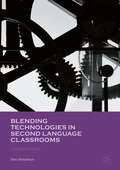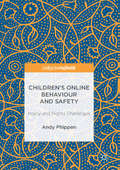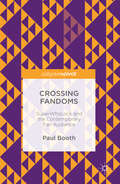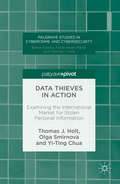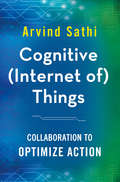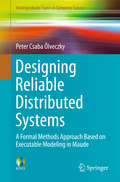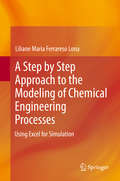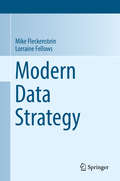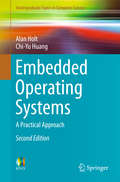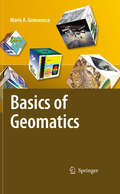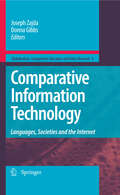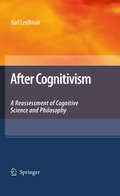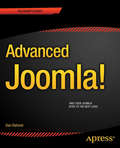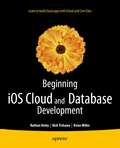- Table View
- List View
Concise Guide to Computation Theory
by Akira MaruokaThis textbook presents a thorough foundation to the theory of computation. Combining intuitive descriptions and illustrations with rigorous arguments and detailed proofs for key topics, the logically structured discussion guides the reader through the core concepts of automata and languages, computability, and complexity of computation. Topics and features: presents a detailed introduction to the theory of computation, complete with concise explanations of the mathematical prerequisites; provides end-of-chapter problems with solutions, in addition to chapter-opening summaries and numerous examples and definitions throughout the text; draws upon the author's extensive teaching experience and broad research interests; discusses finite automata, context-free languages, and pushdown automata; examines the concept, universality and limitations of the Turing machine; investigates computational complexity based on Turing machines and Boolean circuits, as well as the notion of NP-completeness.
Advanced Mechanics in Robotic Systems
by Nestor Eduardo Nava RodríguezHumans have always been fascinated with the concept of artificial life and the construction of machines that look and behave like people. As the field of robotics evolves, it demands continuous development of successful systems with high-performance characteristics for practical applications. Advanced Mechanics in Robotic Systems illustrates original and ambitious mechanical designs and techniques for developing new robot prototypes with successful mechanical operational skills. Case studies are focused on projects in mechatronics that have high growth expectations: humanoid robots,robotics hands,mobile robots,parallel manipulators, andhuman-centred robots.A good control strategy requires good mechanical design, so a chapter has also been devoted to the description of suitable methods for control architecture design. Readers of Advanced Mechanics in Robotic Systems will discover novel designs for relevant applications in robotic fields, that will be of particular interest to academic and industry-based researchers.
Computational Optimization of Internal Combustion Engines
by Rolf D. Reitz Yu Shi Hai-Wen GeComputational Optimization of Internal Combustion Engines presents the state of the art of computational models and optimization methods for internal combustion engine development using multi-dimensional computational fluid dynamics (CFD) tools and genetic algorithms. Strategies to reduce computational cost and mesh dependency are discussed, as well as regression analysis methods. Several case studies are presented in a section devoted to applications, including assessments of: spark-ignition engines,dual-fuel engines,heavy duty and light duty diesel engines.Through regression analysis, optimization results are used to explain complex interactions between engine design parameters, such as nozzle design, injection timing, swirl, exhaust gas recirculation, bore size, and piston bowl shape. Computational Optimization of Internal Combustion Engines demonstrates that the current multi-dimensional CFD tools are mature enough for practical development of internal combustion engines. It is written for researchers and designers in mechanical engineering and the automotive industry.
Computer Vision Using Local Binary Patterns: Computer Vision Using Local Binary Patterns (Computational Imaging and Vision #40)
by Guoying Zhao Matti Pietikäinen Timo Ahonen Abdenour HadidThe recent emergence of Local Binary Patterns (LBP) has led to significant progress in applying texture methods to various computer vision problems and applications. The focus of this research has broadened from 2D textures to 3D textures and spatiotemporal (dynamic) textures. Also, where texture was once utilized for applications such as remote sensing, industrial inspection and biomedical image analysis, the introduction of LBP-based approaches have provided outstanding results in problems relating to face and activity analysis, with future scope for face and facial expression recognition, biometrics, visual surveillance and video analysis. Computer Vision Using Local Binary Patterns provides a detailed description of the LBP methods and their variants both in spatial and spatiotemporal domains. This comprehensive reference also provides an excellent overview as to how texture methods can be utilized for solving different kinds of computer vision and image analysis problems. Source codes of the basic LBP algorithms, demonstrations, some databases and a comprehensive LBP bibliography can be found from an accompanying web site. Topics include: local binary patterns and their variants in spatial and spatiotemporal domains, texture classification and segmentation, description of interest regions, applications in image retrieval and 3D recognition - Recognition and segmentation of dynamic textures, background subtraction, recognition of actions, face analysis using still images and image sequences, visual speech recognition and LBP in various applications. Written by pioneers of LBP, this book is an essential resource for researchers, professional engineers and graduate students in computer vision, image analysis and pattern recognition. The book will also be of interest to all those who work with specific applications of machine vision.
Computational Logic and Set Theory: Applying Formalized Logic to Analysis (Texts in Computer Science)
by Martin Davis Domenico Cantone Jacob T. Schwartz Eugenio G. OmodeoThis must-read text presents the pioneering work of the late Professor Jacob (Jack) T. Schwartz on computational logic and set theory and its application to proof verification techniques, culminating in the ÆtnaNova system, a prototype computer program designed to verify the correctness of mathematical proofs presented in the language of set theory. Topics and features: describes in depth how a specific first-order theory can be exploited to model and carry out reasoning in branches of computer science and mathematics; presents an unique system for automated proof verification in large-scale software systems; integrates important proof-engineering issues, reflecting the goals of large-scale verifiers; includes an appendix showing formalized proofs of ordinals, of various properties of the transitive closure operation, of finite and transfinite induction principles, and of Zorn's lemma.
Ingresos pasivos
by Jorge Ledezma Millán Jonathan S. Walker¡Aprende los secretos para construir ingresos pasivos en línea hoy mismo comienza a ganar dinero! ¿Estás enfermo y cansado de trabajar como un perro, y andar a las carreras como todos los demás? ¿Intercambiando tiempo para ganar dinero día tras día, sacrificando tiempo de calidad con amigos y familiares y sin tener nunca suficiente para gastar con tus seres queridos? ¿Qué tal si te dijera en este momento que hay una manera mediante la cual puedes construir un Imperio de Ingresos Pasivos en Línea sin tener que renunciar a tu trabajo diario? ¿La tomarías? El Ingreso Pasivo en Línea es tu mejor solución para ello. Para convertirte en ESE tipo que todos envidien, tienes que comenzar a construir un negocio de ingresos pasivos en línea HOY. Lleva tiempo desarrollar un negocio desde cero. pero este libro le proporcionará los pasos exactos que deberás seguir para comenzar el viaje. En este libro aprenderás lo siguiente: •5 fuentes rentables para construir flujos de ingresos pasivos en línea. •Estrategias específicas sobre cómo hacer crecer las empresas. •Como construir blogs rentables y generadores de cuantiosos ingresos. •Como construir un imperio comercial vendiendo con FBA. •Cómo configurar un sitio web de membresía. •Cómo ganar dinero vendiendo Ebooks en Amazon Kindle Store. •Cómo configurar un canal de Youtube rentable. Recompensas de la construcción de ingresos pasivos en línea: •Podrás viajar por el mundo. •Cumple tus sueños. •Obtén seguridad financiera. •Libérate del estrés financiero. •Compra lo que desees en cualquier momento. Tendrás acceso a todas estas sorprendentes estrategias detalladas a tu medida, paso a paso. Con todo este conocimiento al alcance de la mano, ¿tomarías el
Computer Analysis of Human Behavior
by Theo Gevers Albert Ali SalahThis book provides a broad survey of advanced pattern recognition techniques for human behavior analysis. Clearly structured, the book begins with concise coverage of the major concepts, before introducing the most frequently used techniques and algorithms in detail, and then discussing examples of real applications. Features: contains contributions from an international selection of experts in the field; presents a thorough introduction to the fundamental topics of human behavior analysis; investigates methods for activity recognition, including gait and posture analysis, hand gesture analysis, and semantics of human behavior in image sequences; provides an accessible psychological treatise on social signals for the analysis of social behaviors; discusses voice and speech analysis, combined audiovisual cues, and social interactions and group dynamics; examines applications in different research fields; each chapter concludes with review questions, a summary of the topics covered, and a glossary.
Renda passiva
by Jonathan S. Walker Beatriz AntunesAprenda os segredos para fazer renda passiva online hoje e começar a ganhar dinheiro que irá trabalhar para você! Você está cansado de trabalhar como um cachorro, correndo todos os dias como todo mundo lá fora? Trocando seu tempo por dinheiro dia após dia, sacrificando tempo de qualidade com amigos e família e nunca tendo o suficiente para gastar com seus entes queridos? E se eu dissesse agora mesmo que existe uma maneira de você construir um Império de Renda Passiva online sem ter que largar seu emprego? Você aceitaria isso? Renda Passiva Online é a sua melhor solução para isso. Para ser esse cara que todo mundo tem inveja, você precisará começar a construir um negócio de renda passiva online hoje. Leva tempo para desenvolver um negócio a partir do zero e este livro fornecerá as etapas exatas que você precisará seguir para iniciar essa jornada. Neste livro você vai aprender: 5 fontes rentáveis para construir fluxos de renda passiva online Estratégias específicas sobre como crescer os negócios Crie blogs geradores rentáveis e de alta renda Construindo um império de negócios e vendendo com a FBA Como configurar um site para inscritos Como ganhar dinheiro vendendo Ebooks na Amazon Kindle Store Como configurar um canal rentável no Youtube Resultados ca construção de Renda Passiva Online: Ser capaz de viajar pelo mundo Realizar seus sonhos Ter segurança financeira Seja financeiramente livre de estresse Compre qualquer coisa que você quiser a qualquer momento Você vai obter todas essas estratégias incríveis detalhadas perfeitamente para você passo a passo. Com todo esse conhecimento ao seu alcance, você daria um salto de fé e se tornaria alguém que está financeiramente livre e que tem renda passiva em seus bolsos todos os dias? Alguém que é aposentado antes dos 40 anos e tem a liberdade de viver a vida ao máximo com seus entes quer
Creating and Digitizing Language Corpora: Volume 3: Databases for Public Engagement
by Karen P. Corrigan Adam MearnsThis book unites a range of approaches to the collection and digitization of diverse language corpora. Its specific focus is on best practices identified in the exploitation of these resources in landmark impact initiatives across different parts of the globe. The development of increasingly accessible digital corpora has coincided with improvements in the standards governing the collection, encoding and archiving of 'Big Data'. Less attention has been paid to the importance of developing standards for enriching and preserving other types of corpus data, such as that which captures the nuances of regional dialects, for example. This book takes these best practices another step forward by addressing innovative methods for enhancing and exploiting specialized corpora so that they become accessible to wider audiences beyond the academy.
Cómo hacer dinero con realidad virtual
by Adidas Wilson Marcello OdoardiLa gente ha estado esperando que la realidad virtual despegue durante años y se han sentido decepcionados, hasta hace poco. Muchos cambios ahora prometen un futuro brillante para la realidad virtual, sin embargo los inversores deben estar bien informados sobre varias aspectos del tema antes de sumergirse; ¿como cuáles son los riesgos?, ¿cuán grande será el mercado?, ¿por qué esta estrategia debería jugarse a largo plazo? y ¿quiénes son los principales actores?.
Cyberbullying: Approaches, Consequences and Interventions (Palgrave Studies in Cyberpsychology)
by Lucy R. BettsDrawing on research evidence and media coverage, this book explores a number of key debates surrounding cyberbullying. The increasing digitization of society affords many benefits; however, some of these benefits are offset by more adverse consequences. Cyberbullying represents one of the adverse consequences of technology use, which has become a topic of increasing societal concern. Betts adopts a critical stance to exploring issues around the definition of cyberbullying, the unique nature of cyberbullying compared to other forms of bullying, the variation in the reported prevalence rates of cyberbullying, the consequences of involvement in cyberbullying, and the steps that can be taken to tackle cyberbullying.
Blending Technologies in Second Language Classrooms
by Don HinkelmanThis book introduces an approach for making principled decisions about the use of technologies specifically in Applied Linguistics. The research is grounded in the growing area of 'blended learning' that seeks to combine face-to-face instruction with online-based interactions to record students using a foreign language productively.
Children’s Online Behaviour and Safety: Policy and Rights Challenges
by Andy PhippenThis book explores the use of technology in young people's social lives against a backdrop of "online safety measures" put in place by the UK government to ensure safe and risk free engagement with online services. The UK landscape is used as a case study to compare the grass roots of digital behaviours with attempts by policy makers to control access and prohibit "bad" behaviours. In conducting an analysis of current UK policy positions and media perspectives against ethnographic research in areas such as gaming and sexting, the book highlights the flaws in approaching the control of disruptive social behaviours using prohibitive approaches. It also highlights the gulf between the experiences of young people and the capabilities of the school system to deliver effective education around safe online behaviours. The author illustrates the complex relationship young people have with technology, as active engagers rather than passive consumers, and looks at the ways in which their needs for effective education and resilience are currently not being met. Furthermore, he demonstrates how, in an effort to make them safe, stakeholders are eroding children's fundamental rights. Children's Online Behaviour and Safety will be of interest to scholars, practitioners and students researching and practicing in education, sociology, children's law, children's digital rights and social policy.
Crossing Fandoms: SuperWhoLock and the Contemporary Fan Audience
by Paul BoothThis book examines the fan-created combination of Doctor Who, Sherlock, and Supernatural as a uniquely digital fan experience, and as a metaphor for ongoing scholarship into contemporary fandom. What do you get when you cross the cult shows Doctor Who, Supernatural, and Sherlock? In this book, Paul Booth explores the fan-created crossover universe known as SuperWhoLock--a universe where Sherlock Holmes and Dean Winchester work together to fight monsters like the Daleks and the Weeping Angels; a world where John Watson is friends with Amy Pond; a space where the unique brands of fandom interact. Booth argues that SuperWhoLock represents more than just those three shows--it is a way of doing fandom. Through interviews with fans and analysis of fan texts, Crossing Fandoms: SuperWhoLock and the Contemporary Fan Audience also demonstrates how fan studies in the digital age can evolve to take into account changing fan activities and texts.
Data Thieves in Action: Examining the International Market for Stolen Personal Information (Palgrave Studies in Cybercrime and Cybersecurity)
by Thomas J. Holt Olga Smirnova Yi-Ting ChuaThis book examines the practices of cybercriminals who steal and sell personal information acquired through various means, including mass data breaches, to engage in cybercrime and fraud. Using data from multiple English and Russian language web forums, the authors identify the range of products sold in these active on-line marketplaces and the prospective profits earned by these actors. The social organization of these markets is analysed using sociological theory to understand the sophistication of the markets. Social network analyses of the relational networks of participants are also utilised to examine their sophistication and structure. In doing so, this work will contribute to the development of cybercrime studies, and will appeal to both social and computer scientists alike with an interest in the human aspects of cybercrime.
Cognitive (Internet of) Things: Collaboration to Optimize Action
by Arvind SathiThis book explores cognitive behavior among Internet of Things. Using a series of current and futuristic examples - appliances, personal assistants, robots, driverless cars, customer care, engineering, monetization, and many more - the book covers use cases, technology and communication aspects of how machines will support individuals and organizations. This book examines the Cognitive Things covering a number of important questions: * What are Cognitive Things? * What applications can be driven from Cognitive Things - today and tomorrow? * How will these Cognitive Things collaborate with each and other, with individuals and with organizations? * What is the cognitive era? How is it different from the automation era? * How will the Cognitive Things support or accelerate human problem solving? * Which technical components make up cognitive behavior? * How does it redistribute the work-load between humans and machines? * What types of data can be collected from them and shared with external organizations? * How do they recognize and authenticate authorized users? How is the data safeguarded from potential theft? Who owns the data and how are the data ownership rights enforced? Overall, Sathi explores ways in which Cognitive Things bring value to individuals as well as organizations and how to integrate the use of the devices into changing organizational structures. Case studies are used throughout to illustrate how innovators are already benefiting from the initial explosion of devices and data. Business executives, operational managers, and IT professionals will understand the fundamental changes required to fully benefit from cognitive technologies and how to utilize them for their own success.
Designing Reliable Distributed Systems
by Peter Csaba ÖlveczkyThis classroom-tested textbook provides an accessible introduction to the design, formal modeling, and analysis of distributed computer systems. The book uses Maude, a rewriting logic-based language and simulation and model checking tool, which offers a simple and intuitive modeling formalism that is suitable for modeling distributed systems in an attractive object-oriented and functional programming style.Topics and features: introduces classical algebraic specification and term rewriting theory, including reasoning about termination, confluence, and equational properties; covers object-oriented modeling of distributed systems using rewriting logic, as well as temporal logic to specify requirements that a system should satisfy; provides a range of examples and case studies from different domains, to help the reader to develop an intuitive understanding of distributed systems and their design challenges; examples include classic distributed systems such as transport protocols, cryptographic protocols, and distributed transactions, leader election, and mutual execution algorithms; contains a wealth of exercises, including larger exercises suitable for course projects, and supplies executable code and supplementary material at an associated website.This self-contained textbook is designed to support undergraduate courses on formal methods and distributed systems, and will prove invaluable to any student seeking a reader-friendly introduction to formal specification, logics and inference systems, and automated model checking techniques.
A Step by Step Approach to the Modeling of Chemical Engineering Processes
by Liliane Maria Ferrareso LonaThis book treats modeling and simulation in a simple way, that builds on the existing knowledge and intuition of students. They will learn how to build a model and solve it using Excel.Most chemical engineering students feel a shiver down the spine when they see a set of complex mathematical equations generated from the modeling of a chemical engineering system. This is because they usually do not understand how to achieve this mathematical model, or they do not know how to solve the equations system without spending a lot of time and effort.Trying to understand how to generate a set of mathematical equations to represent a physical system (to model) and solve these equations (to simulate) is not a simple task. A model, most of the time, takes into account all phenomena studied during a Chemical Engineering course. In the same way, there is a multitude of numerical methods that can be used to solve the same set of equations generated from the modeling, and many different computational languages can be adopted to implement the numerical methods. As a consequence of this comprehensiveness and combinatorial explosion of possibilities, most books that deal with this subject are very extensive and embracing, making need for a lot of time and effort to go through this subject. It is expected that with this book the chemical engineering student and the future chemical engineer feel motivated to solve different practical problems involving chemical processes, knowing they can do that in an easy and fast way, with no need of expensive software.
Modern Data Strategy
by Mike Fleckenstein Lorraine FellowsThis book contains practical steps business users can take to implement data management in a number of ways, including data governance, data architecture, master data management, business intelligence, and others. It defines data strategy, and covers chapters that illustrate how to align a data strategy with the business strategy, a discussion on valuing data as an asset, the evolution of data management, and who should oversee a data strategy. This provides the user with a good understanding of what a data strategy is and its limits. Critical to a data strategy is the incorporation of one or more data management domains. Chapters on key data management domains—data governance, data architecture, master data management and analytics, offer the user a practical approach to data management execution within a data strategy. The intent is to enable the user to identify how execution on one or more data management domains can help solve business issues. This book is intended for business users who work with data, who need to manage one or more aspects of the organization’s data, and who want to foster an integrated approach for how enterprise data is managed. This book is also an excellent reference for students studying computer science and business management or simply for someone who has been tasked with starting or improving existing data management.
Embedded Operating Systems
by Alan Holt Chi-Yu HuangThis easy-to- follow textbook/reference guides the reader through the creation of a fully functional embedded operating system, from its source code, in order to develop a deeper understanding of each component and how they work together. The text describes in detail the procedure for building the bootloader, kernel, filesystem, shared libraries, start-up scripts, configuration files and system utilities, to produce a GNU/Linux operating system. This fully updated second edition also includes new material on virtual machine technologies such as VirtualBox, Vagrant and the Linux container system Docker.Topics and features: presents an overview of the GNU/Linux system, introducing the components of the system, and covering aspects of process management, input/output and environment; discusses containers and the underlying kernel technology upon which they are based; provides a detailed examination of the GNU/Linux filesystem; explains how to build an embedded system under a virtual machine, and how to build an embedded system to run natively on an actual processor;introduces the concept of the compiler toolchain, and reviews the platforms BeagleBone and Raspberry Pi; describes how to build firmware images for devices running the Openwrt operating system.The hands-on nature and clearly structured approach of this textbook will appeal strongly to practically minded undergraduate and graduate level students, as well as to industry professionals involved in this area.
Basics of Geomatics
by Mario A. GomarascaThis volume presents a comprehensive and complete treatment. In a systematic way the complex topics and techniques are covered that can be assembled under Geospatial Information namely, Geodesy, Cartography, Photogrammetry, Remote Sensing, Informatics, Acquisition Systems, Global Positioning Systems, Digital Image Processing, Geographic Information Systems, Decision Support Systems, and WebGIS. It describes in detail and at an accessible level - too much math has been avoided - the state of current knowledge. Per chapter a detailed bibliography has been included. As such, it will serve as a working tool not only to geoscientists and geographers but also to engineers, architects, computer scientists, urban planners, specialists in GIS, remote sensing, forestry, agricultural science, soil science geometry, environmental scientists and managers. Applications can be found in security, risk management, monitoring, info-mobility, geo-positioning, food traceability, etc. From the reviews: "The book is rigorous and synthetic, describing with precision the main instruments and methods connected to the multiple techniques today available. The objective pursued is to publish an integrated text, containing simple and comprehensible concepts relevant to experts in Geo-spatial Information." S. Dequal, Professor of Topography and Photogrammetry, DITAG, Polytechnic of Turin, Italy "This book fills a void of telling and showing the reader how remote sensing as a part of geomatics really works. With a clearly presented historical review up to the present time, the author illustrates the basic theories and use of the different remote sensing sensors and how to analyze the data from them for their application. This book would be a complement to the standard remote sensing books and I would highly recommend it for all land oriented professionals and especially graduate students who need a clear explanation of how remote sensing works". Chris J. Johannsen, Professor Emeritus of Agronomy, Department of Agronomy, Purdue University, West Lafayette, Indiana, USA "Basics of Geomatics" is structured in a clear and effective way into thematic chapters that provide a fundamental, yet comprehensive coverage of each of the major disciplines making up the field of Geomatics. Thanks to its clarity and completeness, the text, supplemented by many useful tables and illustrations will serve as a basic reference work for both beginners and experienced readers". John L. van Genderen, Professor, International Institute for Geoinformation Science and Earth Observation (ITC), Department of Earth Observation Science, Enschede, The Netherlands.
Comparative Information Technology: Languages, Societies and the Internet (Globalisation, Comparative Education and Policy Research #4)
by Joseph Zajda Donna GibbsThis volume offers a critique of the nexus between ICT and its impact on society, individuals and educational institutions. One of the most significant dimensions of globalisation has been the rapid development of information and communications technologies (ICTs). Our lives have been changed by ICTs in numerous ways and the implications for education are enormous. The ICTs have transformed the linguistic, cognitive and visual dimensions of human communication, as well as our perceptions of the self, and social identity in the global culture. They have facilitated the development of new dimensions of digital literacy, such as blogging and sms messaging. In this sense, cyberlanguage continues to evolve by borrowing and adapting familiar words, coining new expressions, and embracing particular styles. The book provides directions in education and policy research, relevant to transformational educational reforms in the 21st century.
After Cognitivism: A Reassessment of Cognitive Science and Philosophy
by Karl LeidlmairThis book comprises a collection of papers dealing with the reassessment of thinking in Cognitive Science and in Philosophy today. Still dependent on basic assumptions of Cartesian philosophy, Cognitive Science took over the mistakes of classical computational models. Instead of being treated as mere or pure explanations of mental processes with hindsight, these models were mistakenly used as more or less literal causal descriptions of the (working of the) mind. A clear insight into the relevance of embodied and embedded knowledge is not only a central topic in AI research; it can become a driving force for a reassessment of philosophy. Philosophy, which is struggling with the two opposite alternatives of cultural relativism and rationalism, both of which have turned out to be dead ends, is in need of a reassessment of reasoning. What is needed is a reasoning without reference to ultimate reasons which at the same time is grounded (and doesn't fall into the trap of cultural relativism).
Advanced Joomla!
by Dan RahmelAdvanced Joomla! teaches you advanced techniques for customizing a Joomla! CMS, including creating templates, administration, and building extensions. It will provide the technical know-how and a bonanza of information that will allow you to take your Joomla! sites to the next level. Written by bestselling Beginning Joomla! author Dan Rahmel, Advanced Joomla! picks up right where Beginning Joomla! left off. Amongst other things, it shows you how to integrate advanced features into your Joomla! site, including social networking, blogging, and Google and Yahoo! web services; construct advanced Joomla! templates that use multiple stylesheets; use advanced administration techniques; and employ MySQL data reporting, remote deployment, and quality control using automated testing. Advanced Joomla! assists content providers and web developers in all aspects of Joomla! content creation. For graphic artists and web designers, the professional template techniques and site organization information will prove invaluable. For developers who are weary of the often Byzantine documentation and hunger for clear organized information, Advanced Joomla! holds the key to unlocking the treasures of this advanced CMS system.
Beginning iOS Cloud and Database Development: Build Data-Driven Cloud Apps for iOS
by Brian Miller Nathan Ooley Nick TichawaBeginning iOS Cloud and Database Development gets you started with building apps that use Apple's iCloud. You'll learn the techniques which will enable you to devise and create iOS apps that can interact with iCloud servers. From the basics up, you'll progressively learn how to configure your app for iCloud, upload and download files, implement revisions, add conflict resolution policies, and work with custom documents. There's more! You'll learn how to integrate iCloud with Core Data based applications. Besides technical advice, you'll find suggestions and best practices to design the interaction of iCloud-driven applications. According to many industry sources, analysts, and shows, Apple will rely more and more on iCloud or web apps in the cloud to store and stream data-intensive media and other kinds of apps. As the majority of apps use some sort of data--and that only will grow as apps become more complex with rich and streaming media--this book shows developers how to create apps for iCloud, Apple's new cloud computing storage and data service. What you'll learn How to use, design, and develop for iCloud, including iOS data-driven apps, media apps and more How to work with documents in iCloud How to create custom documents in iCloud How to work with Core Data and iCloud Who this book is for This book is for iOS developers who want to build apps for or that use the new iCloud platform. Table of Contents Cloud Database Development: The Basics Introduction to The Cloud Applications for the Cloud Basic Setup of iCloud and Key-Value Storage iCloud Document Storage with Core Data and UIDocument iCloud with Core Data Connections, Testing, and Submission for Apple
